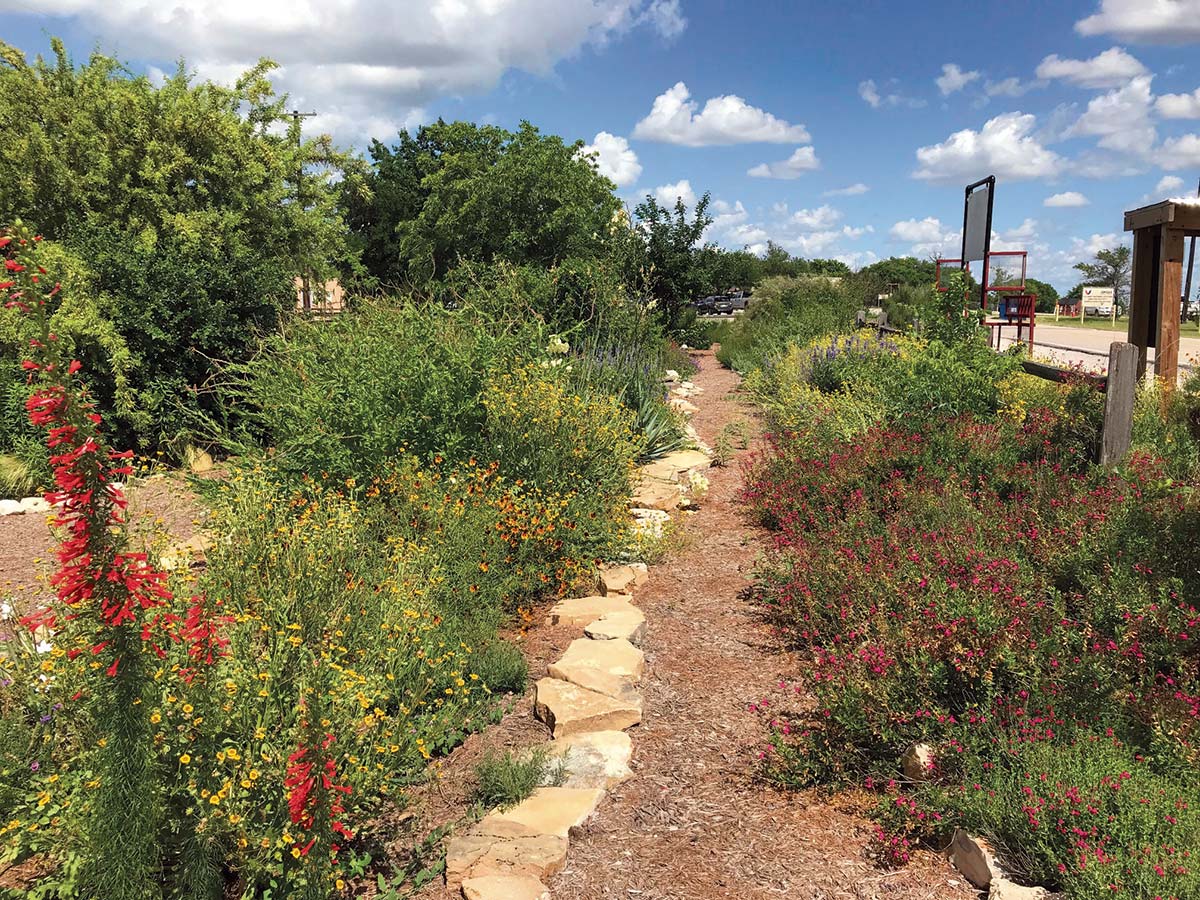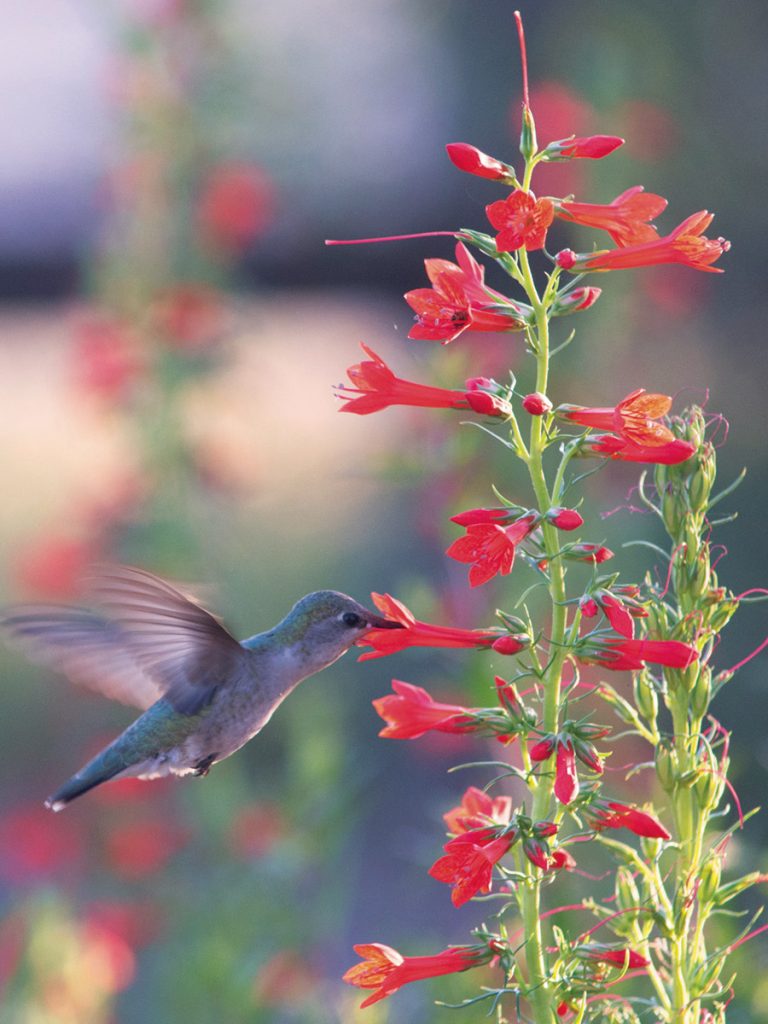Fort Hood’s Native Plant Brigade

Native plants flourish to the delight of humans and pollinators at Fort Hood. PHOTO Jackelyn Ferrer-Perez
At more than 200,000 acres, Fort Hood near Belton, Texas, is one of the largest U.S. military installations in the world.
Yet, amid its rolling, semiarid terrain, near a sprawling maze of streets and buildings, lies an oasis of native plants called the Bird, Bee, Butterfly and Bat Garden. It represents part of the base’s efforts to strike a balance between its natural environment and the military training and testing it exists to provide.
Fort Hood launched its Adaptive and Integrative Management program in 2015 to educate soldiers, contractors and residents about wildlife protection laws and best land management practices; facilitate conservation efforts and partnerships; and identify and proactively manage areas of highest conservation concern. Program Manager Jackelyn Ferrer-Perez, Agronomist Carla Picinich, and Wildlife Management Team Supervisor Amber Preston Dankert serve as boots on the ground (pun intended) for the program.
Picinich came to Fort Hood in 2005 as a biologist for The Nature Conservancy. In 2011, she began working for the Department of Defense as the agronomist for Fort Hood’s Natural Resources Management Branch. “I fell in love with native plants after working summers on The Nature Conservancy’s Joseph H. Williams Tallgrass Prairie Preserve in Oklahoma during my college years,” she says, adding that the original idea for the garden at Fort Hood came from a conversation with a coworker about having a place to showcase native plants and educate people about how easy they are to maintain.
“We started the garden with a [DOD] Legacy Program grant, on what used to be a parking area,” Picinich adds. “We wanted to show people who live on Fort Hood how to use native plants in their landscaping rather than the typical plants you buy at big box stores. The more we showcase the garden, the more things change here.”

A female black-chinned hummingbird (Archilochus alexandri) demonstrates the allure of standing cypress (Ipomopsis rubra). PHOTO Bill Parker.
Bill Parker, a communications employee whose office is near the garden, says he usually stops by on his way to work to photograph flowers and hummingbirds. “This time spent in the garden is very peaceful for me,” he says, adding, “I am very glad this place exists.” A co-worker of Parker’s was similarly inspired; he saw evergreen sumac (Rhus virens) in the garden and later planted it on his own property.
More than 30 species of native plants now grow in the garden, all of them purchased at Wildflower Center plant sales. Wildflower species include flame acanthus (Anisacanthus quadrifidus var. wrightii), black and Gregg dalea (Dalea frutescens and D. greggii, respectively), Texas persimmon (Diospyros texana), purple coneflower (Echinacea purpurea), firewheel (Gaillardia pulchella), prairie verbena (Glandularia bipinnatifida), standing cypress (Ipomopsis rubra) and Texas bluebonnets (Lupinus texensis), along with trees such as desert willow (Chilopsis linearis), a variety of oaks and sumacs (Quercus and Rhus spp., respectively), and Texas mountain laurel (Sophora secundiflora). Other species include catclaw mimosa (Mimosa aculeaticarpa), agarita (Mahonia trifoliolata), possumhaw (Ilex decidua) and several species of sage (Salvia spp.).
“We have added some plants that we grew from seeds, but all the original ones came from the Wildflower Center,” Picinich says. She became a Wildflower Center member many years ago and initially attended plant sales to buy plants for her own native garden.
Another AIM project, the Pollinator Research and Outreach Garden (aka the Pollinator Sanctuary), is currently undergoing expansion with the help of volunteers and a grant from the National Environmental Education Foundation.
“It was an old, abandoned weather station,” says Ferrer-Perez, who works on a variety of projects at Fort Hood under contract from the University of Illinois at Urbana-Champaign’s Department of Natural Resources and Environmental Sciences. “We plan to use it to teach the community more about the connection between landscapes and pollinators. In the 2-acre area around it, we’re restoring native prairie.” A Central Texas native, Ferrer-Perez grew up around the military, which fueled her passion for wildlife management on DOD lands.
To select the best plants to lure pollinators, the team scoured the Xerces Society webpage, explored the Wildflower Center, and looked around the natural areas on the military installation for plants frequented by pollinators. “We planned it so we would have something available most times of the year,” Ferrer-Perez adds. “We also put in milkweed, and we’ve collected a lot of milkweed seeds that we’re propagating in a greenhouse.”
She, too, cites Wildflower Center plant sales as an important source for their efforts, calling them “the most reliable place to get good quality native plants” — adding a special shoutout to our staff and volunteers: “The people there are a huge resource as well. They always help us make good decisions about what will work best in our location.”
AIM team members say their goal moving forward is to produce all plants for the gardens through propagation — which will provide additional opportunities for education, a key component of their efforts (which also include monarch tagging and tours). But they’ll still use Wildflower Center plant sales to fill in and replenish. Ultimately, they hope the native plants they’ve brought to Fort Hood spread beyond the gardens — naturally infiltrating other parts of the installation and beyond.
The Bird, Bee, Butterfly and Bat Garden is always open at 1944 Rod and Gun Club Loop, Fort Hood, Texas; visit Facebook for more info. The Pollinator Sanctuary also has periodic public events.
Melissa Gaskill writes about science, nature and the environment for a variety of publications, including Mental Floss, Newsweek, Men’s Journal and Alert Diver; her books include “A Worldwide Travel Guide to Sea Turtles” and “Best Hikes with Dogs: Texas Hill Country and Gulf Coast.”

